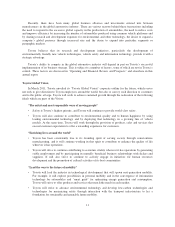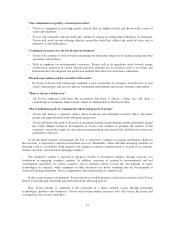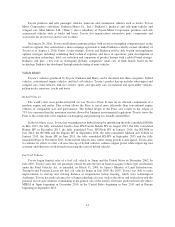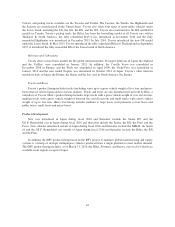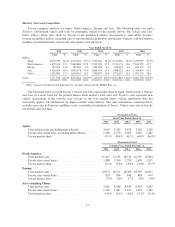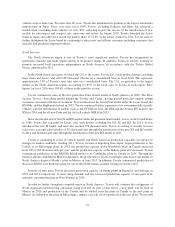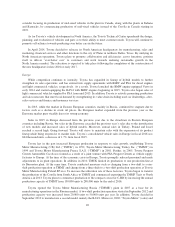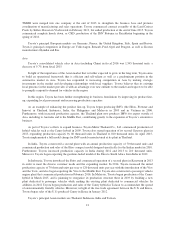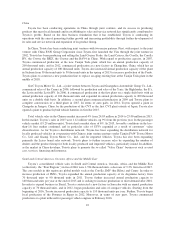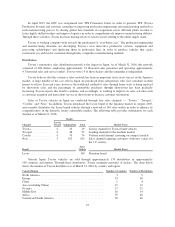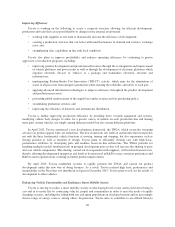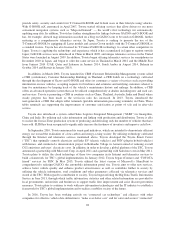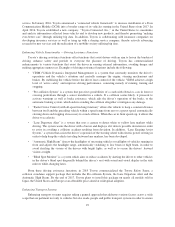Toyota 2015 Annual Report Download - page 25
Download and view the complete annual report
Please find page 25 of the 2015 Toyota annual report below. You can navigate through the pages in the report by either clicking on the pages listed below, or by using the keyword search tool below to find specific information within the annual report.consider focusing its production of mid-sized vehicles in the plant in Canada, along with the plants in Indiana
and Kentucky, by commencing production of mid-sized vehicles instead of the Corolla in Canada starting in
2019.
As for Toyota’s vehicle development in North America, the Toyota Technical Center spearheads the design,
planning, and evaluation of vehicles and parts as to their ability to meet customer needs. Toyota will continue to
promote self-reliance towards producing even better cars in the future.
In April 2014, Toyota decided to relocate its North American headquarters for manufacturing, sales and
marketing, financial services and other functions to the city of Plano in northern Dallas, Texas. By unifying its
North American operations, Toyota plans to promote collaboration and efficiencies across functions, position
itself to deliver “ever-better cars” to customers and work towards realizing sustainable growth in the
North America market. The relocation is expected to take place following the completion of the construction of
the new headquarters in late 2016 or early 2017.
Europe
While competition continues to intensify, Toyota has expanded its lineup of hybrid models to further
strengthen its sales operations, and has entered into supply agreements with BMW and PSA for diesel engines
and light commercial vehicles, respectively. As a result, Toyota launched the BMW engine-equipped Verso in
early 2014 and started equipping the RAV4 with BMW engines beginning in 2015. Toyota also began sales of
light commercial vehicles supplied by PSA from mid-2013. In addition, Toyota is actively promoting production
and sales measures that meet local demand by strengthening its value chain including used car dealerships, after-
sales services and finance and insurance services.
In 2015, while the market in Eastern European countries, mainly in Russia, continued to stagnate due to
factors such as a decline in crude oil prices, the European market expanded from the previous year as the
Eurozone market grew steadily due to its strong economy.
Sales in 2015 in Europe decreased from the previous year due to the slowdown in Eastern European
countries including Russia, but sales in the Eurozone exceeded the previous year’s sales due to the introduction
of new models and increased sales of hybrid models. Moreover, annual sales in Turkey, Poland and Israel
reached a record high. Going forward, Toyota will strive to maintain sales with the expansion of its product
lineup while being responsive to market risks. Toyota’s consolidated vehicle sales in Europe in fiscal 2016 was
844 thousand units, a decrease of 1.7% from fiscal 2015.
Toyota has in the past increased European production in response to sales growth, establishing Toyota
Motor Manufacturing (UK) Ltd. (“TMUK”) in 1992, Toyota Motor Manufacturing Turkey Inc. (“TMMT”) in
1994 and Toyota Motor Manufacturing France S.A.S. (“TMMF”) in 2001. Further, in 2005, Toyota Peugeot
Citroën Automobile Czech was formed as a result of a joint venture with PSA Peugeot Citroën as vehicle supply
factories to Europe. At the time of the economic crisis in Europe, Toyota promptly reduced personnel and made
adjustments to its plant operations. In addition, in 2010, TMUK limited its production to one production line at
its Burnaston plant. At the same time, Toyota conducted measures such as changing from a two-shift to a one-
shift production operation at TMMT and change from a three-shift to a two-shift production operation at Toyota
Motor Manufacturing Poland SP.zo.o. To increase the utilization rate of these factories, Toyota began to transfer
the production of the Corolla from South Africa to TMMT and commenced exporting the TMMF Yaris to North
America in 2013. Toyota plans to commence production of the compact crossover C-HR by increasing the annual
production capacity of TMMT from 150,000 units to 280,000 units by the end of 2016.
Toyota opened the Toyota Motor Manufacturing Russia (“TMMR”) plant in 2007 as a base for its
manufacturing operations in the Russian market. A two-shift production operation started in September 2012 and
production capacity was increased from 20,000 units to 50,000 units per year. In addition, Toyota decided in
September 2013 to manufacture a second model, namely the RAV4. Moreover, OOO “Toyota Motor” (sales) and
20



